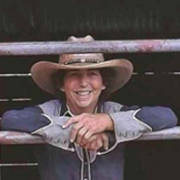Archive for month: July, 2018
MEDC Russell Stover Candies
/in feature article by Kathryn R. Burke/by Kathryn BurkeFeature article.
dawning of a new era
Russell Stover Candies
Story and photos, Kathryn R. Burke
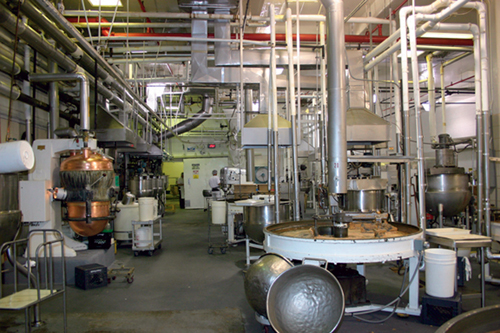 [Montrose Economic Development Corporation, 50th Anniversary Publication]
[Montrose Economic Development Corporation, 50th Anniversary Publication]
“When Russell Stover Candies came to Montrose in 1976, it marked the dawning of a new era,” said MEDC Executive Director, Sandy Head. “Providing a second income for farm families, the successful establishment of the candy company proved to the community that Montrose could be home to a large manufacturer. Two years later, when Holly Sugar pulled its sugar beet processing out of the valley, it took with it one of the largest income crops on the Western Slope.The 200-plus jobs that Russell Stover provided proved even more valuable.” Today, the company employs more than 600 people here.
It’s a sweet operation, and now one of the biggest in western Colorado. Three shifts working in a 300,000 square foot facility produce more than 15,000,000 pounds of candy for what amounts to a five-month selling season. “Most of our product is sold for Christmas, Valentine’s Day, and Easter,” explained Plant Manager Paul Minerich. And much of that is made ahead of time to meet a growing national and international market.
Successful establishment of the candy company proved to the community that Montrose could be a home to a large manufacturer.
The Montrose plant—the others are in Kansas and Texas—and candy-making process are huge. Sugar arrives by rail car, the contents “blown” into 137,000 pound silos. Chocolate, shipped in as ten-pound cakes (1,800 pounds per palette) is stored, tempered by heating to 120 degrees Fahrenheit, blended to a special formula, then cooled to below zero and stored in a vast refrigerated room the size of a football field. Nuts and dairy products (both possible allergens to employees) have their own storage and processing areas. Mixers bigger than a six-foot tall man whip up cremes and fillings. In-progress candies travel along conveyer belt-assembly lines that crisscross the plant like a slow-moving roller coaster, as ingredients are added, confections coated or hand-dipped in chocolate, then tempered, cooled, tooled and packaged, and stored in temperature-controlled rooms. The plant even has its own box-making facility.
 And all this from the Eskimo Pie (invented by Russell Stover’s business partner in 1921) and Clara Stover’s “Bungalo Candies,” first produced in 1923 in Denver when the Stovers became a privately held candy manufacturer. Today, run by the Ward family, who acquired it in 1960 and now also own Whitman’s and Pangburn’s, Russell Stover produces a variety of products including Weight Watcher, Net Carb, sugar-free candies, and their long-standing favorite, boxed chocolates. The company is the nation’s leading manufacturer of boxed chocolates.
And all this from the Eskimo Pie (invented by Russell Stover’s business partner in 1921) and Clara Stover’s “Bungalo Candies,” first produced in 1923 in Denver when the Stovers became a privately held candy manufacturer. Today, run by the Ward family, who acquired it in 1960 and now also own Whitman’s and Pangburn’s, Russell Stover produces a variety of products including Weight Watcher, Net Carb, sugar-free candies, and their long-standing favorite, boxed chocolates. The company is the nation’s leading manufacturer of boxed chocolates.
This article appeared in the Montrose Economic Development Corporation, 50th Anniversary Publication, 2007, which we published for them. During that time, I had an office in the MEDC headquarters, so my staff and I could work closely with Sandy Head, MEDC Executive Director.
___
MEDC Aerospace and Aviation
/in feature article by Kathryn R. Burke/by Kathryn BurkeFeature article.
up up and away
Aerospace and Aviation
Story and photography by Kathryn R. Burke
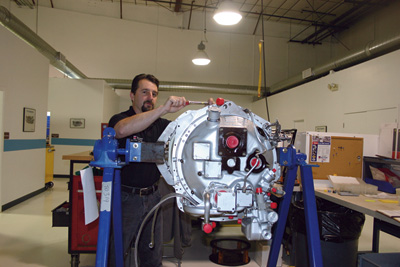 [50th Anniversary Publication] In 1993, Al Head, and David Leis came together along with two additional partners to create a piston aircraft engine shop—Western Skyways. The company’s first location was in the Stryker Industrial Park on North Townsend, not a likely place for an aviation business. It wasn’t long before they outgrew their 4,000 square foot facility.
[50th Anniversary Publication] In 1993, Al Head, and David Leis came together along with two additional partners to create a piston aircraft engine shop—Western Skyways. The company’s first location was in the Stryker Industrial Park on North Townsend, not a likely place for an aviation business. It wasn’t long before they outgrew their 4,000 square foot facility.
With encouragement from MEDC’s Joe Whitley, Steve Glasmann, and Steve Savoy, the partners wound up knocking on MEDC’s door. Soon they were the second tenant in the Aerospace Research Park. “The lot we are on was slated for a bigger operation,” Head says, “but we took it and soon grew into it. It was a dream come true!”
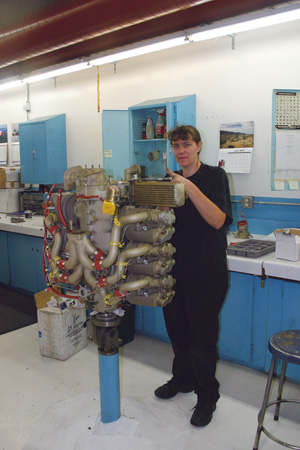 Western Skyways, which employs 79 people, continues to grow, with a piston engine shop at their main location and a turbine engine shop in space rented from JetAway Aviation in an adjacent building.
Western Skyways, which employs 79 people, continues to grow, with a piston engine shop at their main location and a turbine engine shop in space rented from JetAway Aviation in an adjacent building.
Why two locations? “Piston and turbine engines don’t mix,” Head says. “The mechanics don’t run in the same channels, so we keep them in separate buildings.” Over the years it has been recognized that the customer base has changed to turbine powered aircraft. This created an incentive incentive was created to advance and expand into a turbine engine repair shop. They purchased the assets of an existing shop in Georgia and relocated it to Montrose.
Both shops in the Aerospace Research Park are well situated, with enclosed hangar space and runway access. Mechanics can work inside or out, and clients have fly-in fly-out access if they need it. “Planes come in from all over the country, even around the world, for repairs,” notes company president, Head, who along with David Leis, VP of Sales is one of the two remaining partners of the original four.
JetAway, which currently rents space to house the turbine shop, was originally built by Scaled Technology Works (see related story). The company closed the facility in January 2003 and it sat empty until November 2004 before Steve Stuhmer purchased it with the intent of putting a resort condo community for pilots on the site. At this time his plans are still pending. Currently MEDC has two lots left at the park, all with prime runway frontage and good highway access.
Photoraphy
Top left: Engine undergoing repair at Western Skyways turbine shop.
Right: Master Mechanic Melanie Medina, a graduate of Montrose High School’s School to Career program works on engine in Western Skyways ‘prop shop”.
MEDC photos by Kathryn R. Burke.
This article appeared in the Montrose Economic Development Corporation, 50th Anniversary Publication, 2007, which we published for them. During that time, I had an office in the MEDC headquarters, so my staff and I could work closely with Sandy Head, MEDC Executive Director.
Life Lessons from the Horselady
/0 Comments/in feature article by Kathryn R. Burke/by Kathryn BurkeFeature article, cover story.
Life Lessons from the Horselady
Story and Photos by Kathryn R. Burke
[Montrose Monitor, 2014] IN EVERY COMMUNITY – especially the smaller ones like we have in western Colorado – there are usually a few individuals who are truly unique. Not peculiar, not eccentric, but extraordinary, an absolute one-of-a-kind. In our community, Alice Billings certainly fits that description.
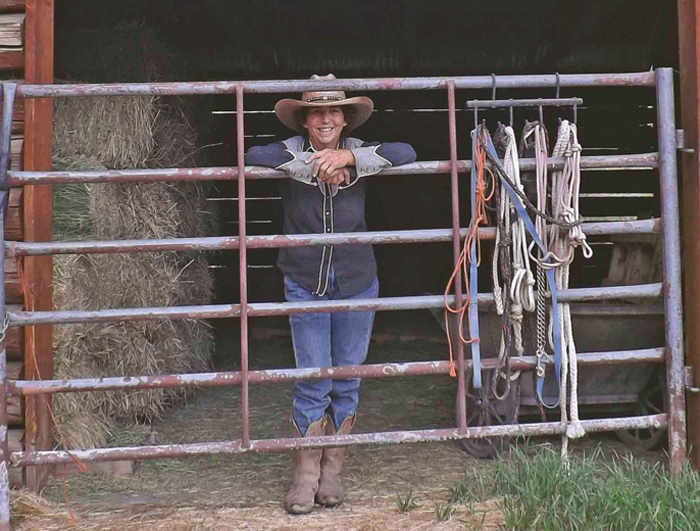
Alice Billings, looking out through the barn gate at Thunder Heart Haven Ranch. Kathryn R. Burke photo.
“Everyone knows where she is and where she’s been,” says a local businessman, whose ice cream shop she frequents. “She leaves a trail wherever she goes!” Alice travels in a cloud of llama hair, bits and pieces of alfalfa, hay, and clumps of what happens after her beloved horses eat both.
When you spot her in the pasture or around town, she’s often dressed in paint-spattered clothing, colorful ‘crocs’ (in summer) or muck boots (in winter), and a beat-up old hat clamped down on her unruly, curly hair. When she’s not working her day job, she’s usually working with horses or painting them. (And occasionally chasing after one of her ‘Houdini’ llamas.)
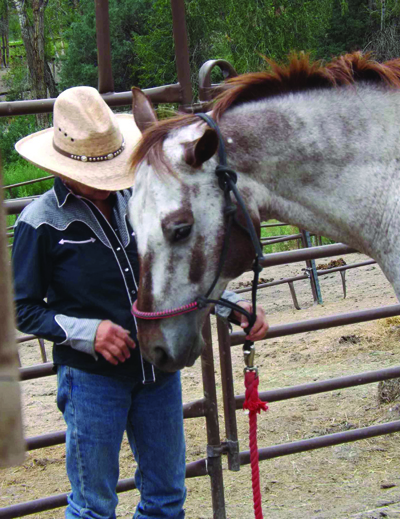
Alice Billings with her Apaloosa, Gus. Kathryn R. Burke photo.
Another thing that earns Alice Billings her billing as “unique” is that she has created herself to be who she was, is now, and wants to be in the future. Alice is the essence of a true renaissance woman: artist, musician, poet, author. Now add educator, equine communicator . . . and self-described ‘horselady.’
Alice’s path to ‘uniquedom’ has not been an easy one; it’s been fraught with curves and switchbacks. She didn’t grow up in a barn, although now she wants to live in one. And although she’s always loved horses and rode as a child, she only recently started riding again (after 35 years). She comes by her art genetically, but her love of horses is learned. Her life journey is a balance of heredity and life experience.
Alice grew up in Queens, the daughter of a Bohemian artist and cartoonist who was also an art teacher. She made her first drawings and paintings working alongside him in his studio. “I was four years old,” she says. “It was from my father that I learned the importance of drawing and of understanding color.” She followed in his footsteps, studying art and music and earning a degree in both.
But the next step in her crooked path took her to Hollywood, then later to Ridgway; she spent 32 years as personal assistant to actor Dennis Weaver in both locations, and worked in Ridgway with a large-animal veterinarian. And she kept on painting. Living in Ridgway, maybe inspired by the Weaver western connection, or influenced by the many ‘horse people’ who live here, Alice began ‘collecting’ real live horses as well as painting them. And all the while her love of horses continued to grow.
She feels there is a special bond between humans and horses. Alice’s ranch, Thunder Heart Haven, is a sanctuary – for her, for ‘senior’ or wild horses that she rescues, for students who want to learn more about the human/equine connection. To foster that relationship, she offers workshops and classes at the ranch. She has also moved her easel to the barn. “The horses are where my heart is,” she explains. “I like to draw and paint them here, to be with them. I plan to build living quarters over the barn, so I can live with them, too.”
Asked where she sees herself in the future, Alice replies: “Where I’d like to be . . . well, I’d like to turn this property into a true sanctuary, a place where I can combine horse consciousness with human consciousness. Horses are very intuitive, and women especially, maybe because they are innate nurturers, relate to them.” Men relate too, but Alice feels the “macho man” mentality often gets in the way. So, she envisions her property evolving into a sort of female human/horse/educational center or retreat. Maybe with three women living on the ranch (house, cabin, her in apartment over the barn), all three involved with the horses in some way.”
As Alice’s philosophical future evolves, so does her art. She is a complex woman. A younger Alice painted with strong line and colorful abandon, mainly with acrylics, and her vibrant equine art is well known in the region. Always strong in drawing, she is experimenting now by combining drawing with water color. “‘Color gets all the credit,’ someone once told me,” she explains, “’but value does all the work.’“
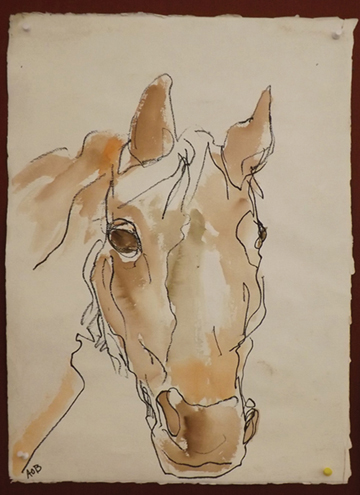
‘Thunder.’ Watercolor by Alice Billings.
Her new work is all about nuances and is reflective of where she’s been and where she’s going next. Like her new, gentler view of her life and her future, watercolor is a subtle, softer medium. It’s refining line, defining shape with shade and shadow. But watercolor is not a splash and dash technique. “My dad, who excelled in watercolor, said it was the most difficult medium to control,” Alice notes. “It dries quickly – in most weather – and once you’ve covered up ‘white space’ with paint, you can’t get it back again. So you work quickly, in layers, building up.”
Kind of like what Alice is doing now as she builds her future. One layer at a time. “Life changes,” she says. “You need to embrace where you are and have trust that you are headed in the right direction. The horses help me do that. They help me understand who and where I need to be.”
Alice’s work my be seen at Art by the Park Gallery, 360 Sherman Street, on the boardwalk across from the Ridgway Town Park. Join Alice and her friends for a special show at the gallery, with a reception hosted by the gallery and Café Ridgway, Saturday, Oct. 11, 2014. 5-8 p.m. Libations, food, music, painting demonstrations. See more of her work at Alice Billing’s website, Horselady.us.
Update. This article was the cover story in the Montrose Monitor, fall issue, 2014. The Monitor is now part of the San Juan Silver Stage. Alice’s work is still available at numerous local galleries including Art by the Park in Ridgway, Colo. She also sells her work and teaches workshops. Learn more at Thunder Heart Haven, Alice’s ranch and Equine Learning Center. which offers Educational Equine Experiences.
Contact me
Subscribe to Newsletter
Social Media, Personal
Visual Communications and Presentation Specialist
Facebook Kathryn Burke Presentations
Twitter Kathryn R Burke
LinkedIn Kathryn Burke
Facebook, Caregiver Journey Burke
Website KathrynRBurke.com
Social Media, Business
Multi-media Marketing and Visual Communications
Facebook San Juan Silver Stage
Facebook San Juan Publishing
Alignable San Juan Publishing
YouTube San Juan Publishing
YouTube San Juan Silver Stage
Website San Juan Publishing
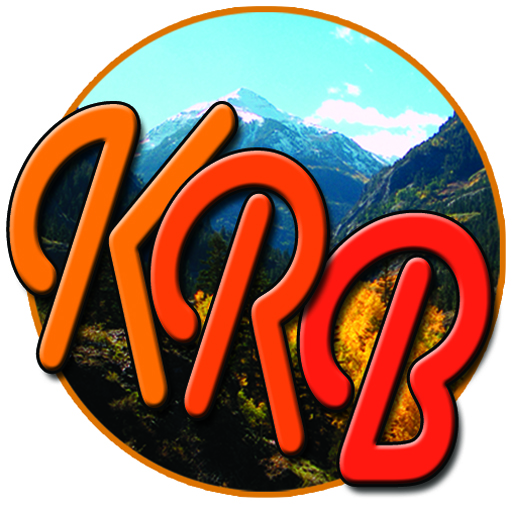
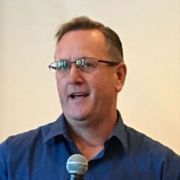 © Kathryn R. Burke
© Kathryn R. Burke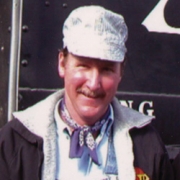 © Bill Colley
© Bill Colley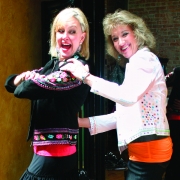 © Kathryn R. Burke
© Kathryn R. Burke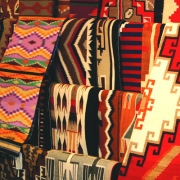 © Kathryn R. Burke
© Kathryn R. Burke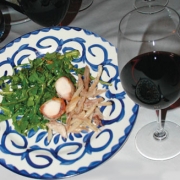 © Kathryn R. Burke
© Kathryn R. Burke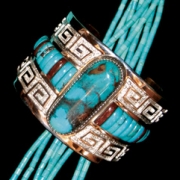 © Kathryn R. Burke
© Kathryn R. Burke © Kathryn R. Burke
© Kathryn R. Burke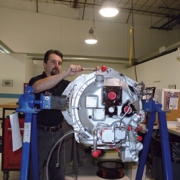 © Kathryn R. Burke
© Kathryn R. Burke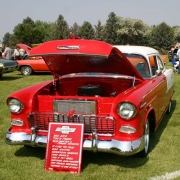 © Kathryn R. Burke
© Kathryn R. Burke